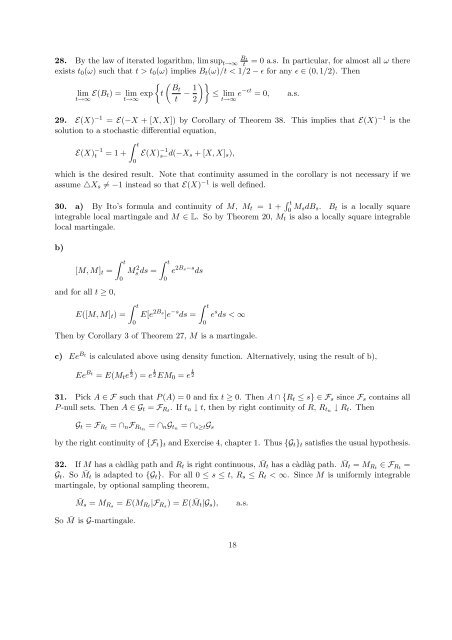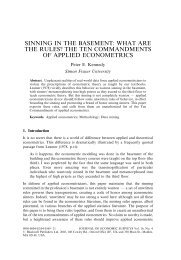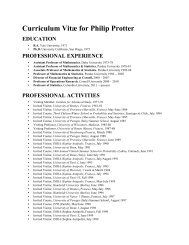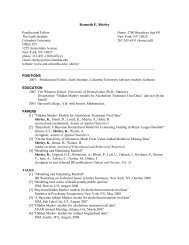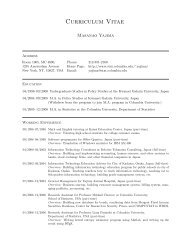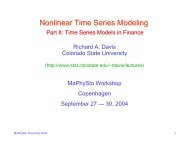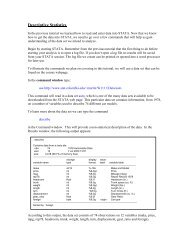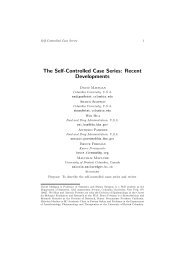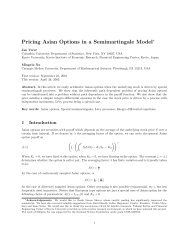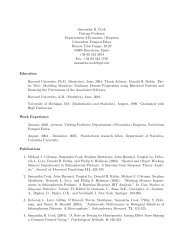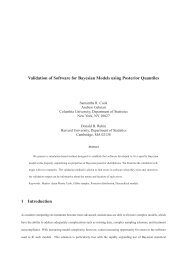Solution to selected problems.
Solution to selected problems.
Solution to selected problems.
Create successful ePaper yourself
Turn your PDF publications into a flip-book with our unique Google optimized e-Paper software.
B<br />
28. By the law of iterated logarithm, lim sup t t→∞ t<br />
= 0 a.s. In particular, for almost all ω there<br />
exists t 0 (ω) such that t > t 0 (ω) implies B t (ω)/t < 1/2 − ɛ for any ɛ ∈ (0, 1/2). Then<br />
{ (<br />
lim E(B Bt<br />
t) = lim exp t<br />
t→∞ t→∞ t − 1 )}<br />
≤ lim e −ɛt = 0, a.s.<br />
2 t→∞<br />
29. E(X) −1 = E(−X + [X, X]) by Corollary of Theorem 38. This implies that E(X) −1 is the<br />
solution <strong>to</strong> a s<strong>to</strong>chastic differential equation,<br />
E(X) −1<br />
t = 1 +<br />
∫ t<br />
0<br />
E(X) −1<br />
s− d(−X s + [X, X] s ),<br />
which is the desired result. Note that continuity assumed in the corollary is not necessary if we<br />
assume △X s ≠ −1 instead so that E(X) −1 is well defined.<br />
30. a) By I<strong>to</strong>’s formula and continuity of M, M t = 1 + ∫ t<br />
0 M sdB s . B t is a locally square<br />
integrable local martingale and M ∈ L. So by Theorem 20, M t is also a locally square integrable<br />
local martingale.<br />
b)<br />
[M, M] t =<br />
and for all t ≥ 0,<br />
∫ t<br />
0<br />
E([M, M] t ) =<br />
M 2 s ds =<br />
∫ t<br />
0<br />
∫ t<br />
0<br />
e 2B s−s ds<br />
E[e 2B s<br />
]e −s ds =<br />
∫ t<br />
0<br />
e s ds < ∞<br />
Then by Corollary 3 of Theorem 27, M is a martingale.<br />
c) Ee Bt is calculated above using density function. Alternatively, using the result of b),<br />
Ee Bt = E(M t e t 2 ) = e<br />
t<br />
2 EM0 = e t 2<br />
31. Pick A ∈ F such that P (A) = 0 and fix t ≥ 0. Then A ∩ {R t ≤ s} ∈ F s since F s contains all<br />
P -null sets. Then A ∈ G t = F Rt . If t n ↓ t, then by right continuity of R, R tn ↓ R t . Then<br />
G t = F Rt = ∩ n F Rt n<br />
= ∩ nG tn = ∩ s≥t G s<br />
by the right continuity of {F t } t and Exercise 4, chapter 1. Thus {G t } t satisfies the usual hypothesis.<br />
32. If M has a càdlàg path and R t is right continuous, ¯Mt has a càdlàg path. ¯Mt = M Rt ∈ F Rt =<br />
G t . So ¯M t is adapted <strong>to</strong> {G t }. For all 0 ≤ s ≤ t, R s ≤ R t < ∞. Since M is uniformly integrable<br />
martingale, by optional sampling theorem,<br />
¯M s = M Rs = E(M Rt |F Rs ) = E( ¯M t |G s ),<br />
a.s.<br />
So ¯M is G-martingale.<br />
18


